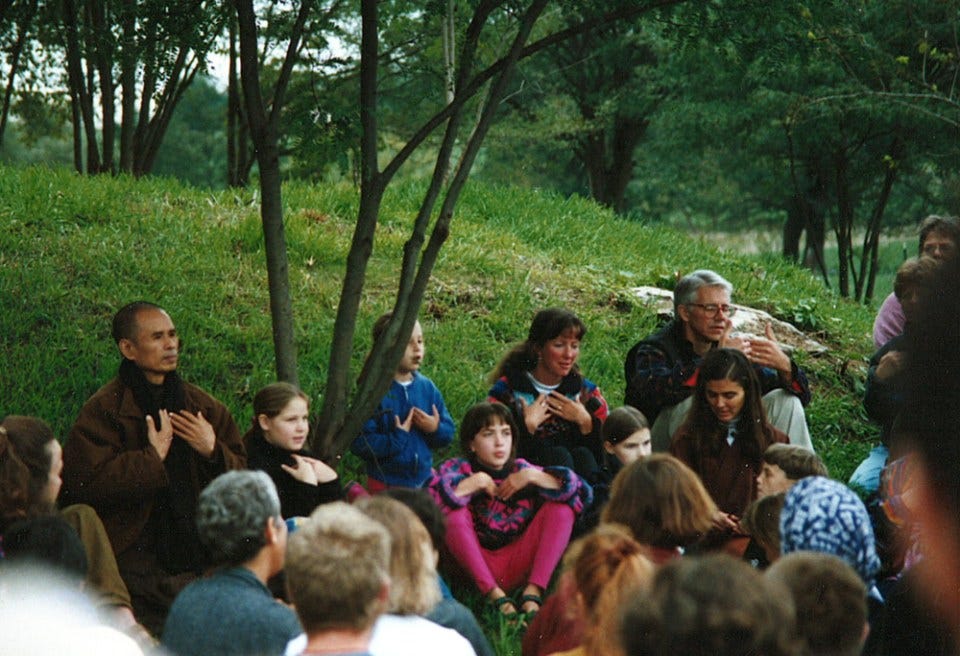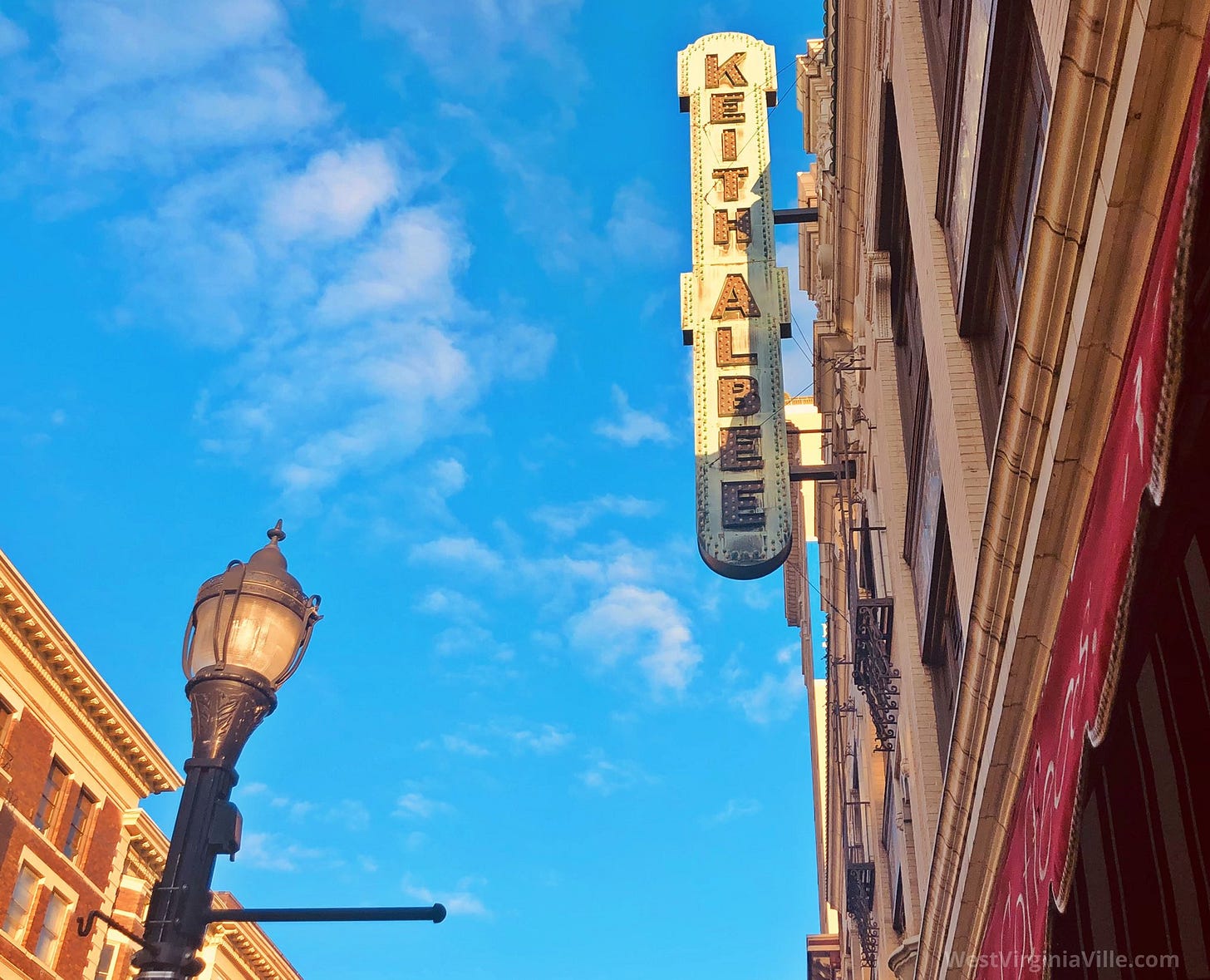Thich Nhat Hahn in West Virginia
When a Buddhist icon walked Bushrod Washington's Panhandle property | Jan26.2022
WestVirginiaVille.com is on on hiatus until March as a monthly digital magazine, while I nurture a book and documentary project. Meanwhile, here’s a piece that reflects our quest to publish unexpected takes from the hills and valleys of the Mountain State. | Peace. Douglas John Imbrogno, Editor

Thich Nhat Hanh in the West Virginia Hills
By Douglas John Imbrogno | WestVirginiaVille.com
NOTE: This article originally appeared in the Jan. 24, 2022 issue of Tricycle.com
In the old photograph, Thich Nhat Hanh gazes kindly in the direction of the camera. In the foreground, the back of a person in a blue sweater with white markings is visible. Thay—a word pronounced ‘tie’ that means “teacher” and how students affectionately addressed Thich Nhat Hanh—looks my way. I’m in the sweater, holding a microphone, about to sing a cappella the ethereal tune “Appalachian Round.”
It is September 1993 and it is a curious thing to be serenading one of Earth’s leading Buddhist teachers of mindfulness and “engaged Buddhism”—his term for walking the talk of spiritual training in daily and worldly life. The better part of a hundred of us have come to a West Virginia retreat led by the world-renowned Vietnamese Buddhist guide.
The silent event, with twice-daily talks by Thay, unfolded at Claymont Court near Charles Town, West Virginia, a sprawling estate once home to George Washington’s grand-nephew. It’s a trifecta of oddball confluences: a Zen Buddhist icon leading silent people in walking and sitting meditation in the West Virginia hills, at Bushrod Washington’s stately old stomping grounds.

I’ll leave to others detailed homages to the remarkable swath Thich Nhat Hanh cut through his notable life. (I recommend Tricycle’s obituary by Joan Duncan Oliver.) I wish only to cast a few rose petals from Appalachia in his wake as we mark his leavetaking.
I had no intention of singing that day. Yet as we gathered beneath sheltering trees, with anthropologist and now Upaya Zen Center abbot Joan Halifax at Thay’s side, a microphone appeared. He asked us to share something. The first thing that seemed appropriate in my head—a song I had just begun singing publicly with a trio—came out.
There was this open-door quality to Thay’s teachings that seemed to welcome such spontaneity. There was also a whole lot of silence once the microphones flicked off. The combination could affect the direction of your daily life.

“That was a relief for me. No need for chit-chat, just the calming silence,” says my friend, Yvonne Farley, who also attended. “That retreat was ‘it’ for my spiritual life. The teachings have stayed with me. That retreat changed my inner life.”
What do we recall from epochal encounters in our spiritual journeying? Little things, often. For Yvonne, it was planters full of red geraniums in the great octagonal Claymont Court barn, where we gathered daily for dharma talks and quiet meditation.
“I got genuine insight there,” says my friend. “A revelation of the power of the moment. And, thus, those red geraniums. It was amazing to me that he conveyed an experience like that.”
I recall sitting on a cushion in the same large space. So many bodies, so many breaths in and out. Thay had a great old bell, big as a footstool, etched with inscriptions. He tapped it and it was so resonant it reverberated for minutes.
There was this open-door quality to Thay’s teachings that seemed to welcome such spontaneity.
As the bell fell quiet that Sunday morning, I heard an approaching sound. Above the roof, out of sight but clear as the ring of that bell, an arrow-line of Canadian geese came honking across the sky.
Then they were gone.
These 30-odd years later, when Canadian geese traverse the skies in my corner of West Virginia—which they do a lot—the sound stirs some of the deep peace of that moment in the presence of Thich Nhat Hanh.
Here’s one last petal of small yet big things he left behind in these hills.
Routinely, but randomly, a bell ringer would appear during the retreat workshops or during our silent meals. The bell ringer would hold up a small, resonant bell, tap it, and then, as Thay instructed, we’d let go of whatever grand important thoughts we were thinking. Dropping them to attend completely to the bell’s reverberations in the room.
Until silence returned.
Ken Lewis, another friend who came to that retreat, told me about teaching a meditation course in rural Roane County, West Virginia, last week, when the world learned of Thich Nhat Hanh’s death.
“I was telling them about the mindfulness bell that was used at that retreat,” he said.
Meditative geese calling in the sky and mindfulness bells rung in the Appalachian hills.
Thank you, Thay. Peace.
Moving Highlights
From porch roosters to slo-mo waterfalls, here are some sights around West Virginia that caught our eye in an AmpMediaProject.com 2021 outtake reel. Most of the imagery in this 5-minute video montage is certified of organic West Virginian origin by the Organic Media Council of Appalachia (a group which doesn’t exist, but should).
From Our Twitter Feed (twitter.com/wvville):
Sometimes, the only thing that makes sense is blue sky. | huntingtonWV | january2022
Leave comments below, or on stories at our site or via this contact form. For e-mails about future monthly issues, free subscribe at: WestVirginiaVille.substack.com.




